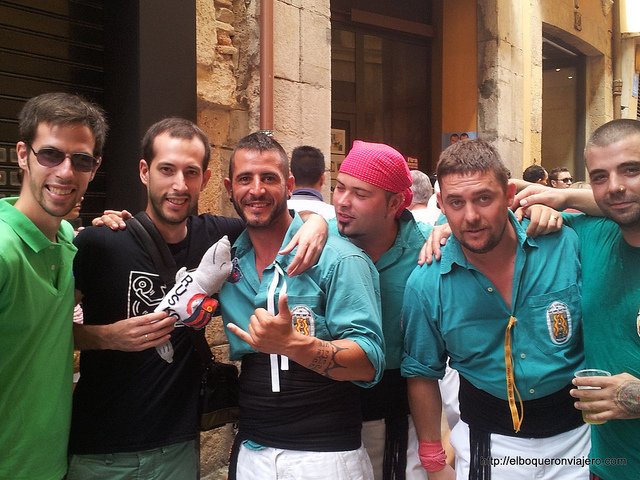The Castells of Tarragona are spectacular, with lots of hard work and effort, they will leave you speechless
My husband, my brother-in-law and I were visiting Tarragona for the first time one Sunday in August during our stay in Barcelona. The sun was hot already, even though it was only about 11am, and we wanted to visit the historic section of this Southern Catalonian city. We turned down the calle de los Pilones (a street with lots of posts painted in vibrant colors, in a sort of street art project), and in the distance you could hear a twisting melody played on an instrument that I’d never heard before. The traditional music accompanied by a drum beat lead us to a narrow street filled with people. These were the famous human towers: The Castells of Tarragona.
 The narrow street was full of people holding their collective breath as a group of castellers constructed one person at a time, this human tower that reached 11 people in height. No nets, no supports, only human strength. In fact, the motto of the castells says it all: strength, balance, bravery and good judgement. This is a tradition that has been around in Southern Catalonia for centuries, and it has been named an UNESCO “Masterpiece of the Oral and Intangible Heritage of Humanity.”
The narrow street was full of people holding their collective breath as a group of castellers constructed one person at a time, this human tower that reached 11 people in height. No nets, no supports, only human strength. In fact, the motto of the castells says it all: strength, balance, bravery and good judgement. This is a tradition that has been around in Southern Catalonia for centuries, and it has been named an UNESCO “Masterpiece of the Oral and Intangible Heritage of Humanity.”
The groups of people that make these human towers are known as “colles.” There is normally one such group per town, and these groups compete, such as in the Tarragona biannual competition. The towers, are obviously complicated with the “pinya” or base section of lots of people supporting the tower, the “folre,” which is basically a second “pinya” a few levels up, and then the “manilles” or third “pinya.” All of these support the pillar, a tall tower of people who rise above the wider base. The result is nothing less than amazing.
The castells of Tarragona are judged on a variety of criteria including height, structure, and technique. And, as you will see, each colle has its own uniform, although they are generally similar, wearing white pants, a wide black belt to support their backs, a red handkerchief on the head and a colored shirt. Depending on the colle, the shirt color is different.
When we were there, it was the first time I had ever witnessed the Castells of Tarragona. The street was packed full of spectators from Tarragona and the surrounding area. People were drinking cold beers and the bars had opened their doors serving tapas as a kind of aperitif. We made our way up the street as close as we could get to the base of these towers which happened to be in the plaza outside the cathedral (Pla de la Seu). After a few minutes we heard the sound of the gralle, a haunting yet festive melody that gave me chills and had me holding my breath as the colle with lavender purple shirts made a human tower, one level after another. I was so nervous for the little boy who climbed up to the top at the end that I had a tear in my eye with the emotions of it all.
 Just as deliberately as each member of the colle had made his or her way up the tower, they climbed back down resulting in a huge cheer and flourish of music. It was such an amazing thing to watch, and the emotions of being able to work together and achieve such a technically difficult goal that I will never forget my first experience with the castells of Tarragona. Even looking back at the photographs we took that morning, I am still brought back to the delicate and triumphant moment when a small boy reached the top of the tower, as well as the relief and pure pride in the group effort we saw when we met with another “colle” with their green shirts.
Just as deliberately as each member of the colle had made his or her way up the tower, they climbed back down resulting in a huge cheer and flourish of music. It was such an amazing thing to watch, and the emotions of being able to work together and achieve such a technically difficult goal that I will never forget my first experience with the castells of Tarragona. Even looking back at the photographs we took that morning, I am still brought back to the delicate and triumphant moment when a small boy reached the top of the tower, as well as the relief and pure pride in the group effort we saw when we met with another “colle” with their green shirts.
This exciting and traditional acrobatic performance literally cannot be missed. If you are lucky enough to be near Tarragona during one of the regions festivals, you simply must go to experience the castells for yourself. We ruskommend the Castells of Tarragona with a golden boqueron for its cultural value, exciting quality, and uniqueness. This is like nothing you’ve ever seen before, and you won’t soon forget the spirit of teamwork, cultural pride, and skill present in these impressive human towers in the northeast corner of Spain.










